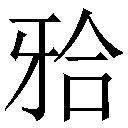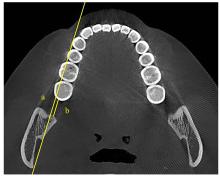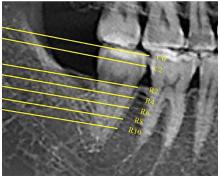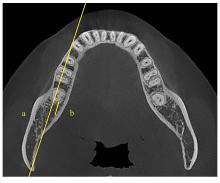吉林大学学报(医学版) ›› 2023, Vol. 49 ›› Issue (6): 1561-1568.doi: 10.13481/j.1671-587X.20230620
CBCT测量不同骨面型患者下颌骨结构特征和磨牙后间隙的影响因素
- 1.吉林大学口腔医院正畸科,吉林 长春 130021
2.河北省唐山市曹妃甸区医院口腔科,河北 唐山 063299
Structural characteristics of mandible in patients with different osteofacial types measured by CBCT and influencing factors of mandibular retromolar space
Yunyun SUN1,Yuguang YAO2,Han ZHANG1,Hanyi LI1,Xianchun ZHU1( )
)
- 1.Department of Orthodontics,Stomatology Hospital,Jilin University,Changchun 130021,China
2.Department of Stomatology,Hospital of Caofeidian District,Tangshan City,Hebei Province,Tangshan 063299,China
摘要:
目的 探讨不同骨面型患者磨牙后间隙的影响因素,分析下颌骨结构特征和磨牙后间隙与颅面部结构的相关性。 方法 选取除第三磨牙外下颌牙列完整且拥挤量<5 mm的成年正畸患者200例,分为骨性Ⅰ类低角组、骨性Ⅰ类均角组、骨性Ⅰ类高角组、骨性Ⅱ类均角组和骨性Ⅲ类均角组。测量各组患者蝶窦A点角(SNA)、蝶窦B点角(SNB)、上下齿槽座角(ANB)、下颌平面角(SN-MP)、面高指数(FHI)、下颌升支长度(Go-Co)和下颌体长度(Go-Gn)。采用锥形束计算机断层扫描技术(CBCT)测量在水平面上与牙尖线平行的下颌 平面及其根方2 mm平面下颌第二磨牙至下颌升支前缘的最短距离C0和C2,釉牙骨质界根方2、4、6、8和10 mm平面的牙根至下颌骨舌侧内层骨皮质的最短距离R2、R4、R6、R8和R10,并采用Spearman相关分析法分析其相关性。 结果 与骨性Ⅰ类低角组比较,骨性Ⅰ类均角组和骨性Ⅰ类高角组患者SN-MP均明显增大(P<0.01),FHI均明显减小(P<0.01)。与骨性Ⅰ类均角组比较,骨性Ⅰ类高角组患者SN-MP明显增大(P<0.01),FHI明显减小(P<0.01)。与骨性Ⅰ类均角组比较,骨性Ⅱ类均角组患者ANB明显增大(P<0.01),骨性Ⅲ类均角组患者ANB明显减小(P<0.01)。与骨性Ⅱ类均角组比较,骨性Ⅲ类均角组患者ANB明显减小(P<0.01)。在C2、R2、R4、R6、R8、R10平面下和Go-Co及Go-Gn中,与骨性Ⅰ类低角组比较,骨性Ⅰ类均角组和骨性Ⅰ类高角组患者下颌磨牙后间隙明显减小(P<0.01);与骨性Ⅰ类均角组比较,骨性Ⅰ类高角组患者下颌磨牙后间隙明显减小(P<0.01)。在C0平面下,与骨性Ⅰ类低角组和骨性Ⅰ类均角组比较,骨性Ⅰ类高角组患者下颌磨牙后间隙明显减小(P<0.01)。在C0、R2、R4、R6、R8和R10平面下,与骨性Ⅰ类均角组比较,骨性Ⅱ类均角组患者下颌磨牙后间隙明显减小(P<0.01),骨性Ⅲ类均角组患者下颌磨牙后间隙明显增大(P<0.01);与骨性Ⅱ类均角组比较,骨性Ⅲ类均角组患者下颌磨牙后间隙明显增大(P<0.01)。在C2平面下和Go-Co及Go-Gn中,与骨性Ⅰ类均角组和骨性Ⅱ类均角组比较,骨性Ⅲ类均角组患者下颌磨牙后间隙明显增大(P<0.01)。骨性Ⅰ类低角组、骨性Ⅰ类均角组和骨性Ⅰ类高角组患者在各平面下颌磨牙后间隙及Go-Co和Go-Gn与SNB和FHI均呈正相关关系(P<0.01),与SN-MP呈负相关关系(P<0.01);各平面下颌磨牙后间隙与Go-Co呈正相关关系(P<0.01);除C2平面,其余各平面下颌磨牙后间隙与Go-Gn呈正相关关系(P<0.01);Go-Co与Go-Gn呈正相关关系(P<0.01);Go-Gn与ANB呈负相关关系(P<0.01)。骨性Ⅰ类均角组、骨性Ⅱ类均角组和骨性Ⅲ类均角组患者在各平面下颌磨牙后间隙及Go-Co和Go-Gn与SNB均呈正相关关系(P<0.01);各平面下颌磨牙后间隙与Go-Co和Go-Gn均呈正相关关系(P<0.01);Go-Co与Go-Gn呈正相关关系(P<0.01);Go-Co与FHI呈正相关关系(P<0.01)。 结论 骨面型是影响下颌磨牙后间隙的重要因素,在正畸制订磨牙远移方案时应参考患者的骨面型,采用CBCT以评估下颌磨牙远移的可用空间。
平面及其根方2 mm平面下颌第二磨牙至下颌升支前缘的最短距离C0和C2,釉牙骨质界根方2、4、6、8和10 mm平面的牙根至下颌骨舌侧内层骨皮质的最短距离R2、R4、R6、R8和R10,并采用Spearman相关分析法分析其相关性。 结果 与骨性Ⅰ类低角组比较,骨性Ⅰ类均角组和骨性Ⅰ类高角组患者SN-MP均明显增大(P<0.01),FHI均明显减小(P<0.01)。与骨性Ⅰ类均角组比较,骨性Ⅰ类高角组患者SN-MP明显增大(P<0.01),FHI明显减小(P<0.01)。与骨性Ⅰ类均角组比较,骨性Ⅱ类均角组患者ANB明显增大(P<0.01),骨性Ⅲ类均角组患者ANB明显减小(P<0.01)。与骨性Ⅱ类均角组比较,骨性Ⅲ类均角组患者ANB明显减小(P<0.01)。在C2、R2、R4、R6、R8、R10平面下和Go-Co及Go-Gn中,与骨性Ⅰ类低角组比较,骨性Ⅰ类均角组和骨性Ⅰ类高角组患者下颌磨牙后间隙明显减小(P<0.01);与骨性Ⅰ类均角组比较,骨性Ⅰ类高角组患者下颌磨牙后间隙明显减小(P<0.01)。在C0平面下,与骨性Ⅰ类低角组和骨性Ⅰ类均角组比较,骨性Ⅰ类高角组患者下颌磨牙后间隙明显减小(P<0.01)。在C0、R2、R4、R6、R8和R10平面下,与骨性Ⅰ类均角组比较,骨性Ⅱ类均角组患者下颌磨牙后间隙明显减小(P<0.01),骨性Ⅲ类均角组患者下颌磨牙后间隙明显增大(P<0.01);与骨性Ⅱ类均角组比较,骨性Ⅲ类均角组患者下颌磨牙后间隙明显增大(P<0.01)。在C2平面下和Go-Co及Go-Gn中,与骨性Ⅰ类均角组和骨性Ⅱ类均角组比较,骨性Ⅲ类均角组患者下颌磨牙后间隙明显增大(P<0.01)。骨性Ⅰ类低角组、骨性Ⅰ类均角组和骨性Ⅰ类高角组患者在各平面下颌磨牙后间隙及Go-Co和Go-Gn与SNB和FHI均呈正相关关系(P<0.01),与SN-MP呈负相关关系(P<0.01);各平面下颌磨牙后间隙与Go-Co呈正相关关系(P<0.01);除C2平面,其余各平面下颌磨牙后间隙与Go-Gn呈正相关关系(P<0.01);Go-Co与Go-Gn呈正相关关系(P<0.01);Go-Gn与ANB呈负相关关系(P<0.01)。骨性Ⅰ类均角组、骨性Ⅱ类均角组和骨性Ⅲ类均角组患者在各平面下颌磨牙后间隙及Go-Co和Go-Gn与SNB均呈正相关关系(P<0.01);各平面下颌磨牙后间隙与Go-Co和Go-Gn均呈正相关关系(P<0.01);Go-Co与Go-Gn呈正相关关系(P<0.01);Go-Co与FHI呈正相关关系(P<0.01)。 结论 骨面型是影响下颌磨牙后间隙的重要因素,在正畸制订磨牙远移方案时应参考患者的骨面型,采用CBCT以评估下颌磨牙远移的可用空间。
中图分类号:
- R783.5






 畸形的相关性探讨[J]. 临床口腔医学杂志, 2018, 34(9): 533-535.
畸形的相关性探讨[J]. 临床口腔医学杂志, 2018, 34(9): 533-535. 成人患者颧牙槽嵴区骨质特征分析及其临床意义
成人患者颧牙槽嵴区骨质特征分析及其临床意义